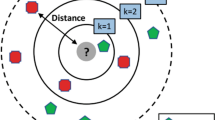Abstract
A method for detecting and classifying faults in an aluminum cantilever beam is proposed in this paper. The method uses features based on second-, third- and fourth-order statistics, which are extracted from the vibration signals generated by the cantilever beam. Fisher’s discriminant ratio (FDR) is used for feature selection, and an artificial neural network is used for fault detection and classification. Three different degrees of faults (low, medium and high) were applied to the cantilever beam, and the proposed pattern recognition system was able to classify the faults, reaching performances ranging from 88 to 100 %. Moreover, the use of higher-order statistics-based features combined with FDR led to a compact feature space and provided satisfactory results.










Similar content being viewed by others
Notes
The overall efficiency is defined here as the average performance of all classes.
References
Abed, W., Sharma, S., Sutton, R., & Motwani, A. (2015). A robust bearing fault detection and diagnosis technique for brushless dc motors under non-stationary operating conditions. Journal of Control, Automation and Electrical Systems, 26(3), 241–254.
Cawley, P., & Adams, R. D. (1979). The location of defects in structures from measurements of natural frequencies. The Journal of Strain Analysis for Engineering Design, 14(2), 49–57.
Compare, M., & Zio, E. (2014). Predictive maintenance by risk sensitive particle filtering. IEEE Transactions on Reliability, 63(1), 134–143.
Farrar, C., & Worden, K. (2012). Structural health monitoring: A machine learning perspective. Hoboken: Wiley.
Garcia, D., & Trendafilova, I. (2014). A multivariate data analysis approach towards vibration analysis and vibration-based damage assessment: application for delamination detection in a composite beam. Journal of Sound and Vibration, 333(25), 7036–7050.
Hadjileontiadis, L. J., Douka, E., & Trochidis, A. (2005). Crack detection in beams using kurtosis. Computers and Structures, 83(12–13), 909–919.
Haykin, S. (2008). Neural networks and learning machines (4th ed.). Cambridge: Academic Press.
Kushner, H. J., & Yin, G. G. (2003). Stochastic approximation and recursive algorithms and applications. New York: Springer.
Liao, W., & Wang, Y. (2013). Data-driven machinery prognostics approach using in a predictive maintenance model. Journal of Computers, 8(1), 255–231.
Mendel, J. M. (1991). Tutorial on higher-order statistics (spectra) in signal processing and system theory: Theoretical results and some applications. Proceedings of the IEEE, 79(3), 278–305.
Nikias, C. L., & Mendel, J. M. (1993). Signal processing with higher-order spectra. IEEE Signal Processing Magazine, 10(3), 10–37.
Patil, D. P., & Maiti, S. K. (2005). Experimental verification of a method of detection of multiple cracks in beams based on frequency measurements. Journal of Sound and Vibration, 281(1–2), 439–451.
Ribeiro, M. V., & Pereira, J. L. R. (2007). Classification of single and multiple disturbances in electric signals. EURASIP Journal on Advances in Signal Processing, 2, 15–15.
Rosales, M. B., Filipich, C. P., & Buezaz, F. (2009). Crack detection in beam-like structures. Engineering Structures, 31(10), 2257–2264.
Ruiz-Gonzalez, R., Gomez-Gil, J., Gil, F. J. G., & Martnez-Martnez, V. (2014). An svm-based classifier for estimating the state of various rotating components in agro-industrial machinery with a vibration signal acquired from a single point on the machine chassis. Sensors, 14(11), 20,713–20,735.
Schmitt, H. L., Scalassara, P. R., Goedtel, A., & Endo, W. (2015). Detecting bearing faults in line-connected induction motors using information theory measures and neural networks. Journal of Control, Automation and Electrical Systems, 26(5), 535–544.
Sinha, K., & Elbhbah, K. (2013). A future possibility of vibration based condition monitoring of rotating machines. Mechanical Systems and Signal Processing, 34(1–2), 231–240.
Theodoridis, S., & Koutroumbas, K. (2008). Pattern Recognition (3rd ed.). Upper Saddle River: Prentice Hall.
Wuxing, L., Tse, P., Guicai, Z., & Tielin, S. (2004). Classification of gear faults using cumulants and the radial basis function network. IEEE Transactions Power Deliver, 18(2), 381–389.
Xiang, J., Matsumoto, T., & Wang Z, Y. (2013). Detect damages in conical shells using curvature mode shape and wavelet finite element method. International Journal of Mechanical Sciences, 66, 83–93.
Yang, X. F., Swamidas, A. S. J., & Seshadri, R. (2001). Crack identification in vibration beams using the energy method. Journal of Sound and Vibration, 244(2), 339–357.
Zarei, J., Tajeddini, M. A., & Karimi, H. R. (2014). Vibration analysis for bearing fault detection and classification using an intelligent filter. Mechatronics, 24(2), 151–157.
Acknowledgments
This work was supported by the Brazilian Agencies FAPEMIG, CAPES, and CNPq.
Author information
Authors and Affiliations
Corresponding author
Rights and permissions
About this article
Cite this article
Barbosa, T.S., Ferreira, D.D., Pereira, D.A. et al. Fault Detection and Classification in Cantilever Beams Through Vibration Signal Analysis and Higher-Order Statistics. J Control Autom Electr Syst 27, 535–541 (2016). https://doi.org/10.1007/s40313-016-0255-1
Received:
Revised:
Accepted:
Published:
Issue Date:
DOI: https://doi.org/10.1007/s40313-016-0255-1




